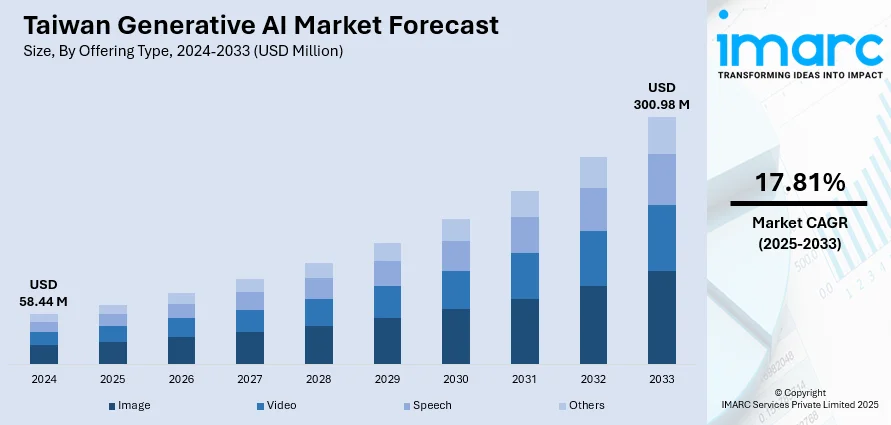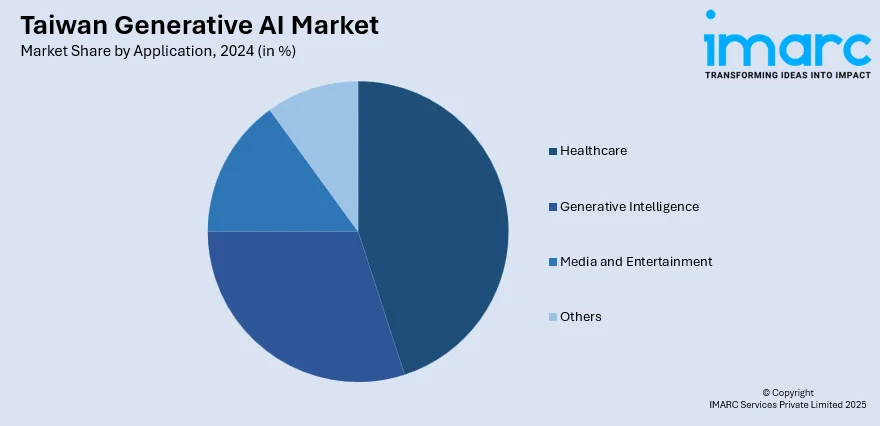
Taiwan Generative AI Market Size, Share, Trends and Forecast by Offering Type, Technology Type, Application, and Region, 2025-2033
Taiwan Generative AI Market Overview:
The Taiwan generative AI market size reached USD 58.44 Million in 2024. The market is projected to reach USD 300.98 Million by 2033, exhibiting a growth rate (CAGR) of 17.81% during 2025-2033. The market is riven by a robust technological setup in the country and the increasing focus on AI research. Also, the increasing use of AI solutions across industries such as manufacturing, healthcare, and finance provide opportunities for generative AI technologies to grow. Moreover, government support and collaboration amongst technological companies are also drivers of innovations and adoption of AI-based technologies, thereby augmenting the Taiwan generative of AI market share.
|
Report Attribute
|
Key Statistics
|
|---|---|
|
Base Year
|
2024
|
|
Forecast Years
|
2025-2033
|
|
Historical Years
|
2019-2024
|
| Market Size in 2024 | USD 58.44 Million |
| Market Forecast in 2033 | USD 300.98 Million |
| Market Growth Rate 2025-2033 | 17.81% |
Taiwan Generative AI Market Trends:
Government Support and Policy Initiatives
The government has increasingly become aware of the potential of generative AI technologies and is actively encouraging their development through a series of initiatives and policies. Apart from this, Taiwan's "AI Action Plan," which aims to improve AI capabilities across various industries, offers funding and incentives to companies and research institutions investing in AI-based solutions. Moreover, the government has promoted collaboration among universities, research institutions, and private enterprises to innovate and develop a talent pool for AI-related industries. As part of this effort, Taiwan's Ministry of Economic Affairs unveiled a strategic initiative on March 26, 2025, aimed at producing 200,000 AI professionals over the next four years. This effort addresses the increasing need for skilled talent throughout the public and private sectors, especially as companies continue to pursue generative AI solutions. The alignment of government policy with industry priorities is providing a conducive environment for AI development. These initiatives ensure that both established players and upcoming startups possess the support structures and skills they need to grow their business, further propelling the Taiwan generative AI market growth.

To get more information on this market, Request Sample
Increasing Investment in AI Startups and Research and Development (R&D)
Taiwan's vibrant startup ecosystem is playing a pivotal role in driving innovation within the generative AI space. The growing interest from both government and private investors in AI startups has led to a surge in funding, enabling new companies to develop cutting-edge AI technologies. Notably, to promote the growth of AI startups, the Ministry will organize networking and matchmaking events throughout the year, focusing on the advancement of AI solutions in industries like healthcare. Additionally, the Ministry of Digital Affairs (MODA) has introduced the Enhanced AI Startup Investment Program, earmarking NT$ 10 Billion (around USD 320 Million) from the National Development Fund. This funding, coupled with private equity investment, will target AI startups and digital economy firms in Taiwan. Moreover, startups are concentrating on a broad set of generative AI uses, such as natural language processing, computer vision, and deep learning, across many industries. This investment has not just propelled the creation of new solutions but also helped to improve the AI research capacity of Taiwan. Besides this, universities and research institutes are also increasingly engaged in AI-related research, generating sophisticated algorithms that fuel breakthroughs for generative models. As the world's competition for AI leadership continues to heat up, Taiwan is emerging as a key center of AI development and research. With significant investment from both the private sector and the government sector, Taiwan seeks to establish itself as the preeminent leader in generative AI innovation.
Taiwan Generative AI Market Segmentation:
IMARC Group provides an analysis of the key trends in each segment of the market, along with forecasts at the country and regional levels for 2025-2033. Our report has categorized the market based on offering type, technology type, and application.
Offering Type Insights:
- Image
- Video
- Speech
- Others
The report has provided a detailed breakup and analysis of the market based on the offering type. This includes image, video, speech, and others.
Technology Type Insights:
- Autoencoders
- Generative Adversarial Networks
- Others
A detailed breakup and analysis of the market based on the technology type have also been provided in the report. This includes autoencoders, generative adversarial networks, and others.
Application Insights:

- Healthcare
- Generative Intelligence
- Media and Entertainment
- Others
The report has provided a detailed breakup and analysis of the market based on the application. This includes healthcare, generative intelligence, media and entertainment, and others.
Regional Insights:
- Northern Taiwan
- Central Taiwan
- Southern Taiwan
- Eastern Taiwan
The report has also provided a comprehensive analysis of all the major regional markets, which include Northern Taiwan, Central Taiwan, Southern Taiwan, and Eastern Taiwan.
Competitive Landscape:
The market research report has also provided a comprehensive analysis of the competitive landscape. Competitive analysis such as market structure, key player positioning, top winning strategies, competitive dashboard, and company evaluation quadrant has been covered in the report. Also, detailed profiles of all major companies have been provided.
Taiwan Generative AI Market News:
- On April 5, 2025, a Taiwanese software developer launched "Mei," a privacy-focused generative AI assistant designed to protect user data. The assistant acts as a proxy, allowing users to interact with popular AI platforms like ChatGPT and Bing without exposing personal information. Currently, Mei has 13,000 users on the Line messaging platform, with features including chatbot access, image generation, translation, and personal finance management.
Taiwan Generative AI Market Report Coverage:
| Report Features | Details |
|---|---|
| Base Year of the Analysis | 2024 |
| Historical Period | 2019-2024 |
| Forecast Period | 2025-2033 |
| Units | Million USD |
| Scope of the Report |
Exploration of Historical Trends and Market Outlook, Industry Catalysts and Challenges, Segment-Wise Historical and Future Market Assessment:
|
| Offering Types Covered | Image, Video, Speech, Others |
| Technology Types Covered | Autoencoders, Generative Adversarial Networks, Others |
| Applications Covered | Healthcare, Generative Intelligence, Media and Entertainment, Others |
| Regions Covered | Northern Taiwan, Central Taiwan, Southern Taiwan, Eastern Taiwan |
| Customization Scope | 10% Free Customization |
| Post-Sale Analyst Support | 10-12 Weeks |
| Delivery Format | PDF and Excel through Email (We can also provide the editable version of the report in PPT/Word format on special request) |
Key Questions Answered in This Report:
- How has the Taiwan generative AI market performed so far and how will it perform in the coming years?
- What is the breakup of the Taiwan generative AI market on the basis of offering type?
- What is the breakup of the Taiwan generative AI market on the basis of technology type?
- What is the breakup of the Taiwan generative AI market on the basis of application?
- What is the breakup of the Taiwan generative AI market on the basis of region?
- What are the various stages in the value chain of the Taiwan generative AI market?
- What are the key driving factors and challenges in the Taiwan generative AI market?
- What is the structure of the Taiwan generative AI market and who are the key players?
- What is the degree of competition in the Taiwan generative AI market?
Key Benefits for Stakeholders:
- IMARC’s industry report offers a comprehensive quantitative analysis of various market segments, historical and current market trends, market forecasts, and dynamics of the Taiwan generative AI market from 2019-2033.
- The research report provides the latest information on the market drivers, challenges, and opportunities in the Taiwan generative AI market.
- Porter's five forces analysis assist stakeholders in assessing the impact of new entrants, competitive rivalry, supplier power, buyer power, and the threat of substitution. It helps stakeholders to analyze the level of competition within the Taiwan generative AI industry and its attractiveness.
- Competitive landscape allows stakeholders to understand their competitive environment and provides an insight into the current positions of key players in the market.
Need more help?
- Speak to our experienced analysts for insights on the current market scenarios.
- Include additional segments and countries to customize the report as per your requirement.
- Gain an unparalleled competitive advantage in your domain by understanding how to utilize the report and positively impacting your operations and revenue.
- For further assistance, please connect with our analysts.
 Request Customization
Request Customization
 Speak to an Analyst
Speak to an Analyst
 Request Brochure
Request Brochure
 Inquire Before Buying
Inquire Before Buying




.webp)




.webp)












